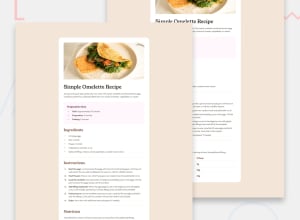
Design comparison
Solution retrospective
In this project I don't have anything to be proud of, I think I could have done a better job, my CSS code could have been more organized, etc... I'm not satisfied with my results in this challenge and I hope I can learn from the mistakes I did.
What challenges did you encounter, and how did you overcome them?I don't really know to be honest, I guess everything was a challenge to me, I struggled a lot with the layout itself, my CSS structure, paddings & margins, etc...
What specific areas of your project would you like help with?- Flexbox;
- Responsiveness.
Community feedback
- @MohammedOnGitPosted about 2 months ago
Hello Soy-Ibrag!!!
Congratulations for completing this challenge. Your HTML for the recipe page is clean and well-structured. Here are some suggestions for improvements:
- Accessibility: Alt Text The alt text for your omelette image can be more descriptive for screen readers:
<img src="assets/images/image-omelette.jpeg" alt="A simple omelette on a plate">- Consistent Heading Levels For better semantic structure, ensure that heading levels follow a logical order: You are using an h1 for the recipe title, followed by an h4 for the preparation time, which might break the logical flow. Consider using h2 for sections like "Preparation time," "Ingredients," "Instructions," and "Nutrition":
<h2>Preparation time</h2>- Use <strong> Instead of <span class="bold"> You are using a span with the class "bold" to make text bold. Instead, use the semantic <strong> tag for emphasis:
<p><strong>Total:</strong> Approximately 10 minutes</p>- Table Structure Your table looks fine but consider using <th> elements for the first column (Calories, Carbs, etc.) to improve semantic meaning:
<tr class="border"> <th scope="row">Calories</th> <td class="value">277kcal</td> </tr>- Add Meta Description Adding a meta description helps with SEO and provides a summary of the content:
<meta name="description" content="A simple and easy-to-follow recipe for making a classic omelette with optional fillings.">These minor adjustments will improve accessibility, performance, and SEO for your recipe page!. Generally you did great. Keep it up!!!
Marked as helpful1@Soy-IbragPosted about 2 months ago@Aggressive-Mohammed Tysm for the suggestions and for taking your time to help me.
1 - @StroudyPosted about 2 months ago
Exceptional work! You’re showing great skill here. I’ve got a couple of minor suggestions that could make this stand out even more…
-
Using a
<main>tag inside the<body>of your HTML is a best practice because it clearly identifies the main content of your page. This helps with accessibility and improves how search engines understand your content. -
Having a clear and descriptive
alttext for images is important because it helps people who use screen readers understand the content, making your site more accessible. It also improves SEO, as search engines usealttext to understand the image's context, helping your site rank better, Check this out Write helpful Alt Text to describe images, -
Your heading elements
<h1><h4>missing h2 h3, Heading elements should be in sequentially-descending order (e.g.,<h1>,<h2>,<h3>) to create a clear content structure, improving accessibility and SEO. Skipping levels or using them out of order can confuse screen readers, affect search engine rankings, and make your content harder to understand.
<h1>Simple Omelette Recipe</h1> <h4>Preparation time</h4>-
Using a full modern CSS reset is beneficial because it removes default browser styling, creating a consistent starting point for your design across all browsers. It helps avoid unexpected layout issues and makes your styles more predictable, ensuring a uniform appearance on different devices and platforms, check out this site for a Full modern reset
-
I think you can benefit from using a naming convention like BEM (Block, Element, Modifier) is beneficial because it makes your CSS more organized, readable, and easier to maintain. BEM helps you clearly understand the purpose of each class, avoid naming conflicts, and create reusable components, leading to a more scalable codebase. For more details BEM,
-
Using
remoremunits in@mediaqueries is better thanpxbecause they are relative units that adapt to user settings, like their preferred font size. This makes your design more responsive and accessible, ensuring it looks good on different devices and respects user preferences.
I hope you’re finding this guidance useful! Keep refining your skills and tackling new challenges with confidence. You’re making great progress—stay motivated and keep coding with enthusiasm! 💻
Marked as helpful0@Soy-IbragPosted about 2 months ago@Stroudy Thanks for your feedback, I'll keep that In mind in future projects!
1 -
Please log in to post a comment
Log in with GitHubJoin our Discord community
Join thousands of Frontend Mentor community members taking the challenges, sharing resources, helping each other, and chatting about all things front-end!
Join our Discord
